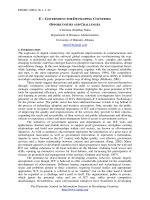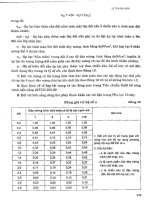Renewable energy technologies for developing countries phần 9 pptx
Bạn đang xem bản rút gọn của tài liệu. Xem và tải ngay bản đầy đủ của tài liệu tại đây (30.2 KB, 9 trang )
- 77 -
side walls of the enclosed reservoir. Part of this energy can then be used to
pump the remaining water to a high-level reservoir, which would operate
a conventional hydro-electric power plant. In this way, with a capital
investment of about US$ 40 million, some 20 MW of electricity can be
generated at a cost of only 30 mils per kW/h. The possible fish output from
the reservoir is estimated at 1,000 tons/ annum and its value may well
exceed that of the electricity.
Tidal-wave power-generation has several advantages over conventional
resources. Some of the primary advantages are: it is a renewable source
of energy; it is pollutionfree; it can produce energy all round the year
(24x7x365 hours / annum). Interestingly, the peak output coincides with
peak energy-demand. Moreover, water is a free resource. Above all, it is
highly efficient (coal/oil efficiency = 30 per cent, tidal power efficiency =
80 per cent).
Some of the potential sites of the world so far surveyed are given
below
6
:
1. Siberia, Russia
2. Inchon, Korea
3. Hangchow, China
4. Hall’s Point, Australia
5. New Zealand
6. Anchorage, Alaska
7. Panama
8. Chile
9. Punta Loyola, Argentina
10. Brazil
11. Bay of Fundy
12. Frobisher Bay, Canada
6. Chapter on “Energy and Environment” in “Global and Environmental Issues”, Ed. Al
Hinnawi and M.H.Hashmi, UNEP, 1982, pp.147-148.
- 78 -
13. England
14. Antwerp, Belgium
15. LeHavre, France
16. Guinea
17. Gujrat, India
18. Burma
19. Semzha River, Russia
20. Colorado River, Mexico
21. Madagascar
The current challenge in younger and experimental renewable energy-
sources is that although they have great potential in serving the energy-
needs of developed and developing countries alike, they first need to prove
their full commercial viability. However, rapid research and development
of these areas and the number of companies working on potentially
commercial technologies is a strong sign that these new renewable
energysources hold great promise for the future.
- 79 -
CHAPTER 7
ENERGY POLICY AND PLANNING
Situation in Developing Countries :
Developing countries generally do not have elaborate policies to
support development of renewables energy technologies. They lack plans
and strategies, laws and regulatory frameworks, market mechanisms,
financial tools, and incentives. However, some have already developed
comprehensive plans and policies amongst these are, Chinese Renewable
Energy Plan; India’s Renewable Energy Programme; Korea’s Basic Plan
for Renewable Energy Technology Development and Dissemination,
Thailand’s Small Power-producer Program, Argentina’s Renewable Energy
and Rural Markets Program, Morocco’s Global Rural Electrification
Programme; and Chile’s Rural National Electrification Program. Certain
international development programs for developing countries are designed
to promote renewable energy with the active role of bilateral and multilateral
assistance-agencies, international financial instititutions (IFIs) or private
foundations.
Affordable commercial energy is a necessity of life, when integrated
with the developmental activity, to improve water-supply, agriculture,
education, health, and transport. The broad policy to encourage sustainable
energy-systems can greatly help in the economic development of the third-
world countries. Key components of the overall strategy for this include :
improving efficiency of fuels, making electricity available in rural, as well
as in urban areas for economic development, providing de-centralized
energy-option, financing rural energy-production, and developing new
institutional structures and public and the very important private partnership.
Many Renewable Energy Technologies are today at, what may be
called, the “take-off” stage. Therefore, it is highly important to undertake
- 80 -
long-term planning, with effective policy-measures. These may be broadly
grouped under the following heads : (1) International, (2) National
Assessment & Planning, (3) Public/private participation and financial
Investments. These are discussed separately as follows :
1. International
In order to accelerate application adaptation, and transfer of the
mature technologies to the developing countries viz energy for mutual
benefit to all, taking into account their special needs of the following
measures are required on an international level :
a) Identify and keep under review, with respect to mature
technologies, the utilization of new and renewable sources of
energy, their role within sectoral programmes and, where
appropriate, establish or strengthen institutional arrangements to
promote their application;
b) Strengthen / establish measures to promote and facilitate the
accelerated transfer of technology on new and renewable sources
of energy, especially from developed to developing countries, in
order to enhance the contribution of these sources to the total
energy-supply of developing countries;
c) Support measures to increase economic and technical cooperation
among developing countries, including the undertaking of joint
programmes of activities;
d) Develop national capabilities to undertake, inter alia, the manufacture,
adaptation, management, repair and maintenance of devices and
equipment related to technologies for the assessment and utilization
of new and renewable sources of energy;
e) Strengthen the ability of developing countries to make financial and
technical evaluations of the different elements of the technologies,
thereby enabling them to better assess, select, negotiate, acquire
and adapt technologies required to utilize new and renewable
sources of energy;
- 81 -
f) Formulate innovative schemes for investments in the area of
manufacturing equipment for new and renewable sources of
energy, especially the establishment of joint industrial programmes
among interested countries, for the manufacturing and commer-
cialization of relevant capital goods;
g) Strengthen national capacity to review and assess domestic, fiscal,
regulatory, sociocultural and other policy-aspects, required to
accelerate the introduction of technologies related to new and
renewable sources of energy;
h) Support, as appropriate, demonstration-projects related to the
application of new and renewable sources of energy and
technologies, prior to a decision on commercial operation and
widespread implementation.
All the above measures would require sizeable investments. These
can be ensured, provided each country decides to invest an appropriate
percentage (from 5% to 10%) of its energy-expenditure on short and
medium-term development of renewable energy technologies. This will
need public consensus, followed by appropriate legislation.
2. National energy assessment and planning
The role of energy, especially that of new and renewable sources of
energy, in meeting the needs of countries, can best be determined in the
context of national energy-planning, an essential element of which is
national energy-assessment. It is an especially acute problem with respect
to the data-infrastructure pertaining to energy-demand and resource-
inventories, as well as the impact on the ecology, which can provide the
basis for assessing the possible future role of new and renewable-energy
sources and related technologies, as well as developing national energy-
policy and plans. Action plan is required as follows :
a) Map, survey and undertake other appropriate activities to determine
the full range of physical resource-endowment, using, whenever
possible, standardized methodologies for collecting data, processing
and storaging as well as for dissemination;
- 82 -
b) Determine, in a dynamic way, energy-supply and demand and
energy balances, and projections of future energy-requirements;
c) Identify, and keep under review, mature and near-term promising
energytechnologies, as well as ongoing research, development
and demonstration activities, and carefully assess their economic,
socio-cultural and environmental cost, potential and benefit;
d) Strengthen and/or establish institutional infrastructure to collect,
maintain, analyze, classify and disseminate information on all the
above, as well as information pertaining to the policy, programme
and project decision-making process, the legislative framework
and related procedures (and their impact on energy supply and
usepatters), and the availability of financing.
The strengthening of national capacities should embrace elements
such as :
a) Establishment or strengthening of appropriate national institutional
arrangements;
b) Adequate research and development programmes, to support the
scientific and technical capacity to develop, choose and adapt
technologies, including testing and demonstration facilities and
research focal-points in new and renewable sources of energy;
c) Specific programmes, to promote the exploration, development
and utilization of new and renewable sources of energy, taking
into account (as appropriate) social, economic and environmental
considerations;
d) Programmes to encourage the efforts of national, public and private
entities in interested countries (as appropriate) to expand the
development and utilization of new and renewable sources of
energy.
e) Mobilization of adequate resources;
f) Develop qualified personnel, for specialized education and training
programmes, equally accessible to men and women.
- 83 -
g) Development and strengthening of industrial capacity to manufacture
adapt, repair and maintain energy-related equipment.
3. Financial investment and public/private
partnership
Based on experience
1
(World Bank/GEF and other international and
national agencies) derived from Chapter-5, the following are general and
financial principles that should be adopted in formulation of energy
policies and action-plans.
1. Governments must create enabling environment, to provide choice
of Alternate/Renewable Energy to its population;
2. Reduction of Governmental subsidy on fossil fuels;
3. Promotion of environment-friendly alternative/renewable energy-
sources, through demonstration;
4. Promotion of Financial for renewable energy;
5. Regulate law, tax-exemption investment, which can attract local
and foreign partnership for investment;
6. Emphasize participation and Institutional-Development.
Based on these principles, specific policies for incorporating renewable
energy within the power-sector re-structuring can be implemented in many
developing countries. One of the important challenge is that international
agencies and developing countries may work together, to develop national
energy-policies and action-plans, using experience, suitable to their own
situation. This can be summarized
2
as under :
a) Encourage Independent Power Producer : Private-sector
involvement and investment in the renewable-energy power-sector are
1. GEF Scientific and Technical Advisory Panel (SATP) 2000, “Report of the STAP
Brainstorming on Power Sector Reform and the role of GEF in promoting Clean Energy
Technologies” GEF/C.16/Inf.15 Nairobi : UNEP/GEF and Washington, DC:GEF
2. Eric Mortinot, “Grid-Based Renewable Energy in Developing Countries : Policies
Strategies and lesson from the GEF”, WRE Policy and Strategy Forum, June 13-15,
2002 Germany.
- 84 -
greatly facilitated by establishing a transparent and stable regulatory
framework. Establishing these conditions can assist in promoting and
developing renewable-energy market development. In many countries,
utility regulatory frameworks exist that allow fair competition.
b) Reduce Subsidies on Fossil-Fuels : Most of the developing
countries provide subsidies on fossil fuel, which should be reduced, to
create a more “LEVEL” playing field. This will make renewable-energy
technologies more competitive in the market.
c) Environmental Standards : Environmental standards should be
implemented on both old and new plants. This will help to promote
environment-friendly renewable technologies; improve emission standards,
monitoring requirements and other aspects, which can further strengthen
the power-sector.
d) Renewable Energy Quotas : All developing countries should set
minimum percentage of renewable energy power consumed / produced on
the total national energy-requirement. The national plan should provide
further encouragement with a “renewable energy year.” These programmes
have been adopted in some European countries, viz. Denmark, Italy and
Netherland, and are being proposed e.g in Japan, India and Portugal.
Netherlands does have a national target to produce from renewable sources,
17% of all electricity produced from energy in 2020.
e) Guaranteed Market : One of the effective ways to facilitate and
encourage the use of renewable energy products by governments is to
provide subsidies that can be reduced over time. This would allow
renewable-energy products to find a foothold in the market and expand to
create a stable economic market of their own. For this to be made entirely
successful it is important for governments to buy renewable energy products
themselves. This will not only help to establish a guaranteed market but
will also provide the required “demonstration effect” to win the trust of
other buyers. Building the public sector as well as organizations encourage
implementation of renewable energy technologies for demonstration and
help to increase the marketability (market size).
- 85 -
As a whole, European policy calls for 12% of energy supply from
renewables by 2010. China and India also have national goals : in China,
renewables should account for 5% of annual energy being added by 2010,
and in India this percentage is 10% by 2012, and in order to achieve this
goal every country needs to set aside an appropriate percentage of national
expenditure on energy-sector for relevalent research, development and
extension. Every country/region should set its own goal and adopt appropriate
resources for achieving this.
Conclusion :
We may summarize the immediate needs, as follows :
i) Development of National Policy Framework
ii) National Plan indicating priority-projects for demonstration.
iii) Fund Allocation
iv) Private - Public Participation
v) Regulatory measures :
- Incentives
- Financing System for Private Sector
- Market Development (Economic Size)









